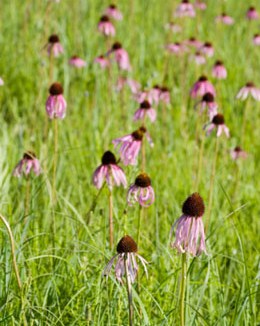A plant native to the prairies of the south central United States, the pale purple coneflower is popular as a herb, as well as a garden plant.

These plants are mainly grown for ornamental and medicinal purposes. It is believed that the pale purple coneflower has the ability to boost the immune system. Often seen in the wild as a single-branched plant, they are multi-stemmed clusters in gardens. This plant is often mistaken for purple coneflower (
Echinacea pallida), which is its distant relative. The purple coneflower has brighter petals and broader leaves, when compared to the pale purple coneflower.
Physical Features
Pale purple coneflowers are perennial plants, that can grow up to three feet in height. As already stated, the wild ones have a single main stem, whereas those in gardens have many stems. Usually, the stems are green in color, but some plants have shades of purple or red. The stems possess coarse hair, which are whitish in color. Most of the leaves are concentrated near the base of the plant. There are very few leaves on the stems, and the basal leaves have long stalks. The leaves have rough surfaces, parallel veins, coarse white hair, and tapering tips. The leaves of this plant can have a maximum length of ten inches, and a width of up to two inches.
Normally, a single daisy-like flower can be seen at the tip of each stem. The width of the flower can be between one to three inches, and the color of the petals ranges from pale rose to purple and white. In pale purple coneflowers, the petals are ray florets, that can be around 12 to 20 in number. They are slender, long, and drooping. The reddish-brown cone of disc florets in the center are surrounded by these narrow ray florets. The flowering season starts with the early summer, and lasts for at least three weeks. As the season ends, the ray florets shrivel away, and the color of the disk florets' cone turns to black. The fruits, called 'cypselae', have angled edges. These plants have a deep spindle-shaped taproot system.
Range, Habitat, and Planting
The pale purple coneflower, which is native to the south central United States, is widely distributed in the states of Illinois, Michigan, Alabama, and Texas. Though found in the states of Tennessee and Wisconsin, it is a threatened species in these regions. Their habitat includes dry black soil prairies, savannas, abandoned fields, limestone glades, and open areas adjacent to railroads.
These plants are mainly grown for prairie landscaping, native gardens, roadside gardens, wildlife food, medicinal uses, etc. A seedbed should be prepared for planting the seeds. It should be firm enough to plant the seeds 1/8 inch deep. The seedbed can be subjected to chemical weed control measures. Most people prefer dormant seeds for planting, as they give good results. It takes about two months to break dormancy, provided the environment is cold and moist. Fertilizers should be used sparingly, to reduce the growth of weeds. Regular weeding is necessary for the healthy growth of the plant.
Being a wild plant, pale purple coneflowers have minimal requirements. They are drought-resistant, and are resistant to many diseases as well. You can easily grow these plants and enhance the beauty of your garden.






 These plants are mainly grown for ornamental and medicinal purposes. It is believed that the pale purple coneflower has the ability to boost the immune system. Often seen in the wild as a single-branched plant, they are multi-stemmed clusters in gardens. This plant is often mistaken for purple coneflower (Echinacea pallida), which is its distant relative. The purple coneflower has brighter petals and broader leaves, when compared to the pale purple coneflower.
These plants are mainly grown for ornamental and medicinal purposes. It is believed that the pale purple coneflower has the ability to boost the immune system. Often seen in the wild as a single-branched plant, they are multi-stemmed clusters in gardens. This plant is often mistaken for purple coneflower (Echinacea pallida), which is its distant relative. The purple coneflower has brighter petals and broader leaves, when compared to the pale purple coneflower.